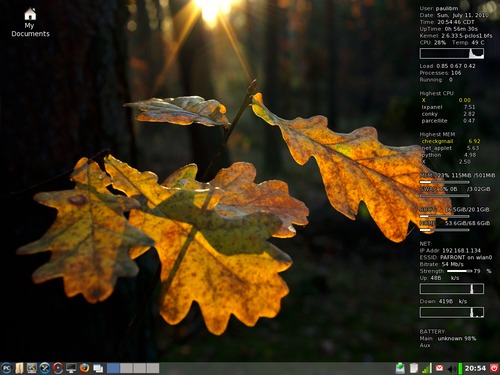LXDE: An Overview
by Paul Arnote (parnote)
One thing Linux users have become accustomed to is choice. And choices abound for almost anything and everything, including desktop environments. Previously, we've covered KDE 4 and Xfce 4.6.2. Now, it's time to take a look at the LXDE desktop.

My LXDE desktop, with some degree of customization of the panel and running Conky.
Lightweight X11 Desktop Environment ("LXDE") is one of the newest desktop environments. It began in 2006 when Hong Yen Jee of Taiwan, better known by his nickname "PCMan", introduced the PCMan File Manager, or PCManFM. Today, the LXDE project is an international collaboration of developers, designers, and contributors from all around the world. Similar to the Xfce and Gnome desktop environments, LXDE is built with the Gtk+ 2.0 libraries.
Living up to the first word in its name, LXDE truly is a lightweight desktop environment. Consequently LXDE thrives on older hardware. On my computer (IBM Thinkpad T23, Pentium III, 1.13 GHz, 512 MB RAM), LXDE uses only 115 MB RAM when it's fully booted, and running a handful of panel plugins, checkgmail, and Conky. LXDE is even capable of running on a Pentium II with only 128 MB RAM.
The "newness" of LXDE shines through, however. Probably the first thing to hit you is the lack of configuration options that are available via a graphical user interface. If you are expecting to find oodles of configuration options, as you would find in KDE or Xfce, you will be disappointed. That doesn't mean that you can't configure LXDE as you might like. It just means that you will have to find the configuration files and edit them by hand. For this reason, the LXDE desktop environment isn't necessarily for new users or the faint-of-heart. It's geared more towards intermediate to advanced users who don't mind digging deep into the configuration files and getting their hands dirty.

Once you figure out how to manipulate and mold LXDE's configuration however, you will be treated to a desktop environment that lives up to its name. LXDE is fast, even on older hardware. Your older computers will feel as if they have been re-invigorated with new life. Many users compare the LXDE desktop appearance to KDE 3.5.x. It does have a lot of similarities in appearance. LXDE adheres to the desktop standards laid out by freedesktop.org.
LXDE is only a desktop environment, and officially relies on the OpenBox window manager to handle the windows on your computer. So, many of the things we'll talk about for LXDE will also apply to the OpenBox version of PCLinuxOS.
Overall, you will probably like LXDE, but you will most likely fall in love with its simplicity and speed. By digging into the configuration files stuffed deep into sub-directories of sub-directories of sub-directories scattered across your hard drive, you may also learn a lot that will transfer to other desktop environments. We will take a look at the basic configuration options, then some more advanced options. We'll attempt to demystify some of LXDE's intricacies, thus improving your ability to tailor LXDE to be what you want it to be.
I am sure of one thing: this old Pentium III Thinkpad T23 has never run so fast. I doubt your results will differ much from mine.